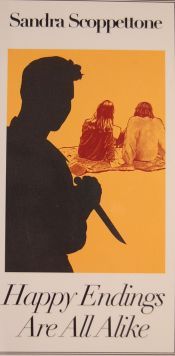Happy Endings Are All Alike might seem like an odd choice for Guys Lit Wire, where we aim to recommend books for primarily teenage boys, but this is a really interesting historical novel that provides a unique peek at life for GBLTQ teens in the 1970s. Any teen interested in life for this minority group in the recent past is going to be fascinated by this novel and likely also horrified by the events that take place in the course of the story.
The plot is fairly straightforward: high school seniors Jaret and Peggy have fallen in love and are looking forward to spending the summer together before they each go away to different colleges. In small town Gardener's Point, 100 mile north of NYC, their relationship is new and not celebrated by everyone. The girls are lowkey and largely preoccupied with coming out to their families, each of which has its own domestic concerns.
Peggy's family in particular is struggling as her mother recently died and her older sister has returned home from college to take on a motherly role which is more self-serving than generous. Claire is on a serious martyr trip and Peggy would just as soon she leave, but her father is too consumed by grief to resume his parental role. Peggy is stuck with Claire's nosy attention and her sister, having discovered Peggy's relationship with Jaret, is holding it over her head. There is little love lost between the sisters, with jealousy, primarily over their mother's love, the root of a longheld anger on the part of Claire. Now that she knows about Peggy & Jaret, here's some of what Claire thinks:
She could have killed them. They were disgusting. So smug, self-satisfied. So sure of themselves all the time. And what were they anyway? Queers. Dykes. Perverts. She'd learned in her psychology classes they were sexually immature, retarded. It was sick. And it made her want to vomit.
Yeah, nothing good going to come from that sibling relationship.
The bigger problem, is one of their classmates who is even more jealous and more disgusted by the two girls. Fueled by anger, he violently attacks Jaret, determined to teach her what "a real man is like". The attack, and subsequent criminal investigation, forces Jaret to go public about her attacker's motivations if she wants to find justice. She makes the decision to embrace her sexual orientation which means Peggy is forced out of the closet as well, unless she calls Jaret a liar to protect her reputation. Again, here's Claire practicing some Psch 101 on her sister:
It's clear to me that what you've done is to make Jaret a surrogate mother. It's a dependency problem at the root. Still, it's revolting." Claire chewed her lip.
You can't stand it that two people might just love each other, can you?"
Claire flinched. "Lesbianism is immature, Peggy."
There is also some eye-opening discussion about how allegations of rape were handled by the police 35 years ago:
Mr. Tyler, sir," said the chief, full of condescension, "I have experience in these matters. A boy, a girl, a little kissing, maybe some petting, naturally a boy gets excited and then the girl says no. The poor boy goes crazy with frustration and—"
The whole story is eyebrow raising on multiple fronts and although the narrative can be a bit confusing when the different points-of-view are first introduced, soon enough readers will find themselves unable to look away as the would-be attacker becomes bolder and bolder.
I wish Happy Endings Are All Alike could be dismissed as sheer fantasy but as any student of social history knows, there is a lot of truth to this novel. Read it to know what life was like not too long ago for far too many teens, and then be eternally grateful that you are coming-of-age today when someone like Claire, and the attacker, are more clearly the deviant and monster.
[The upper cover is of the new rerelease of Happy Endings Are All Alike from the wonderful imprint, Lizzie Skurnick Books. The more lurid cover is from its late 1970s/early 1980s heyday.]



No comments :
Post a Comment
Note: Only a member of this blog may post a comment.